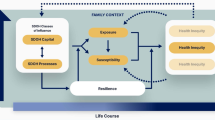Abstract
Agenda-setting is the process by which problems and alternative solutions gain or lose public and elite attention. This study aimed to demonstrate new population policy agenda-setting in Iran using the multiple streams model developed by John Kingdon. The study was conducted using a qualitative approach in the years of 2014–2015 and consisted of 15 semi-structured interviews with Iranian key informants. The sampling was purposeful and continued using snowball method until the data saturation is reached. In addition, 25 policy documents were reviewed and analyzed. The data analysis was conducted using the framework analysis by MAXQDA software. The problem stream was highlighted with the release of 2006 census and reaching total fertility rate to below the replacement level in Iran. Political stream formed by supporting the high-ranking officials of the country, academics and researchers, the mass media, clergy and particularly leadership. Policy stream continued with policies such as the future plan of children [Barname-e-Atiyeh], funding removal for population control and also abolished the previous limiting rules, formulation of the new law on the maternity leave. Finally, with the overall population policies notification by the supreme leader of the revolution, the window of opportunity was opened and the issue of population growth was set as agenda. In conclusion, application of the multiple streams model and identification of its various aspects in the new approach of the population policy in Iran would assist policy-makers and officials in this area of policy to recognize the problem better and thereby make more evident and rich policies. Further studies to understand better the interactions between these streams and development of this model in the country population policy recommended.


Similar content being viewed by others
References
Abbasi-Shavazi, M.J., Hosseini-Chavoshi, M.: Fertility developments in Iran in the past four decades: using and evaluating their children fertility estimates using 1986–2011. The Institute for Statistics Report, Tehran (2013) (in Persian)
Abbasi-Shavazi, M.J., Hosseini-Chavoshi, M.: Population trends and policies in Iran: The necessity for comprehensive national population plan. J. Popul. Assoc. Iran 7(13), 95–117 (2012) (in Persian)
Beland, D.: Ideas and social policy: an institutionalist perspective. Soc. Policy Adm. 1, 1–18 (2005)
Best, J. (ed.): Social Problems. Norton, W.W.New York (2013)
Blumer, H.: Social problems as collective behavior. Soc. Probl. 18(3), 298–306 (1971)
Brunner, S.: Understanding policy change: multiple streams and emissions trading in Germany. Glob. Environ. Chang 18(3), 501–507 (2008)
Buse, K., Mays, N., Walt, G. (eds.): Making Health Policy. Open University Press, London (2005)
Fischer, F., Miller, G., Sidney, S.: Handbook of Public Policy Analysis: Theory, Politics, and Methods, Public Admin and Public Policy/125, pp. 63–78. CRC Press, Boca Raton (2007)
Greathouse, L.W., Hahn, E.J., Okoli, C.T., Warnick, T.A., Riker, C.A.: Passing a smoke-free law in a pro-tobacco culture: a multiple streams approach. Policy Polit. WHO Tech. Rep. Ser. 6(3), 211–220 (2005)
Hilgartner, S., Charles, L.: The rise and fall of social problems: a public arenas model. Am. J. Sociol. 94(1), 53–78 (1988)
Islamic Consultative Assembly News Agency (ICANA): http://www.icana.ir/fa/News (2013). Accessed 29 October 2013 (in Persian)
Kingdon, J. (ed.): Agendas, Alternatives and Public Policies. Harper Collins, New York (1995)
Lewins, A., Silver, C.: Using Software in Qualitative Research: A Step-by-Step Guide. Sage, Los Angeles (2007)
Liu, X., Lindquist, E., Vedlitz, A., VincentLiu, K.: Understanding local policy-making: policy elites’ perceptions of local agenda-setting and alternative policy selection. Policy Stud. J. 38(1), 69–91 (2010)
Mahmoodi, K., Mohammadpur, A., Rezaei, M.A.: Discourse analysis of population policies in the context of politics in Iran. Qual. Quant. 49(5), 1883–1895 (2015) (in Persian)
Mahmoodian, H.: The Family Knowledge. SAMT Publication, Tehran (2008) (in Persian)
McCombs, M., Shaw, D.: The agenda-setting function of mass media. Public Opin. Q. 36(2), 176–187 (1972)
Minstry of Health, Treatment and Medical Education: http://www.behdasht.gov.ir/news (2012). Accessed 21 November 2013 (in Persian)
Population Association of Iran: http://www.paiassoc.ir (2013). Accessed 6 March 2013 (in Persian)
Ritchie, J., Lewis, J.: Qualitative Research Practice: A Guide for Social Science Students and Researchers. Sage Publications, London (2003)
Sabatier, P.A., Weible, C. (eds.): Theories of the Policy Process. Westview Press, Boulder (2014)
Samiei Nasab, M., Torabi, E.: Indicators and population policy in Iran. J. Bardashte Dowom 7(11 & 12), 143–188 (2010) (in Persian)
Scheufele, D.A., Tewksbury, D.: Framing, agenda-setting, and priming: the evolution of three media effects models. J. Commun. 57(1), 9–20 (2007)
Supreme Council of Cultural Revolution: The national program for population growth and fertility rates improving, the population policy adopted by the Supreme Council of Cultural Revolution. Tehran: Center for Women’s Affairs and Family (2013) (in Persian)
Waters, J.: Snowball sampling: a cautionary tale involving a study of older drug users. Int. J. Soc. Res. Methodol. 18(4), 367–380 (2015)
Wee-Ming, T.: Multiple streams of change: explaining the removal of Singapore’s casino ban using John Kingdon’s agenda-setting model. Asian J. Public Aff. 2(1), 39–53 (2008)
Women’s Affairs and Family of Presidency: www.women.gov.ir/ (2014). Accessed 21 June 2015 (in Persian)
Zahariadis, N.: Ambiguity and choice in European public policy. Eur. Public Policy 15(4), 514–530 (2008)
Zahariadis, N.: The multiple streams model: structure, limitations, prospects. In: Sabatier, P.A. (ed.) Theories of the Policy Process: Theoretical Lenses on Public Policy, pp. 65–92. Westview Press, Boulder (2007)
Acknowledgments
This article is taken from the PhD thesis in health and management policy. The authors sincerely express their thanks to all participants in the study. In addition, we warmly appreciate Mahmoud Ghazi Tabatabei, Professor of Demography and Health Sciences at the University of Tehran, and Research Associate of the Department of Gerontology at Simon Frasier University, Canada for his constructive and insightful comments on the earlier draft of this manuscript.
Author information
Authors and Affiliations
Corresponding author
Ethics declarations
Conflict of Interest
The authors declare that they have no conflict of interest.
Rights and permissions
About this article
Cite this article
Jafari, H., Pourreza, A., Vedadhir, A. et al. Application of the multiple streams model in analysing the new population policies agenda-setting in Iran. Qual Quant 51, 399–412 (2017). https://doi.org/10.1007/s11135-016-0311-8
Published:
Issue Date:
DOI: https://doi.org/10.1007/s11135-016-0311-8




